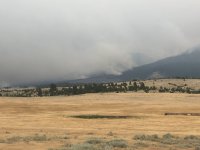I retired from Fremont Co. Fire Protection Dist. in Wyoming after 30 years of service. During those 30 years, I spent around 20 summers on wildland fires going clear back to the days of engine strike forces. After I retired, I spent another half dozen fire seasons on campaign fires as a single resource, most often deployed as an engine ninja, training, or my favorite gig, Safety Officer (fire line safety, and/or team).
I had some great pictures of some of the most devastating fires to hit Idaho, western Washington, and Colorado in decades. I deleted most of those pictures when the cheese finally slide off of my cracker (PTSD) and the pics got too hard to look at. I had some really good pics of the South Canyon fire when every thing went gunny sack on July 6, 1994. Most folks have never heard of the South Canyon Fire. It was on storm King Mountain where 14 firefighters perished. Anyhow, I am rambling. The following are some photos from NFIC photographer Kari Greer's archives.
Pic of my mentor, George Marcott, on the Trinity Ridge Fire in Idaho in 2012
Another pic from Trinity Ridge. The vehicle to the very extreme far right is the front end of my ride. I am in the group under the bright lights.
Pic of the 911 VLAT. It's a cool air plane for sure. I have watched millions of dollars of taxpayer money spew out that baby.
Generic pic of a fire storm circa 2012. I have seen a lot of these. I ain't gonna lie they are pretty cool. Some of them sound exactly like a freight train rolling down a canyon.
I could ramble on for hours. I'll leave you folks with this thought. There was time when I would go on a ride as safety with a structure protection specialist to triage houses. We would drive through the wildland urban interface and pull up right in the drive way. If the owner had taken steps as recommended by fire wise, the house would generally be "defensible". OTOH, if no steps were taken at all, with wooden shakes, ladder fuels right up to the door, and so forth, the structure would be "indefensible" and just another piece of fuel, no different than a blade of grass.













